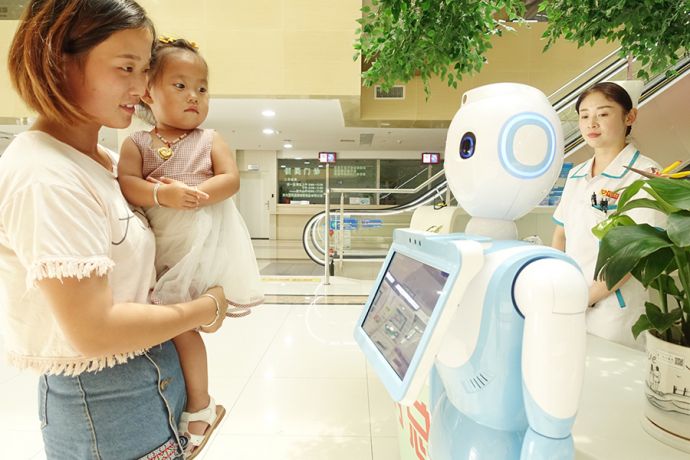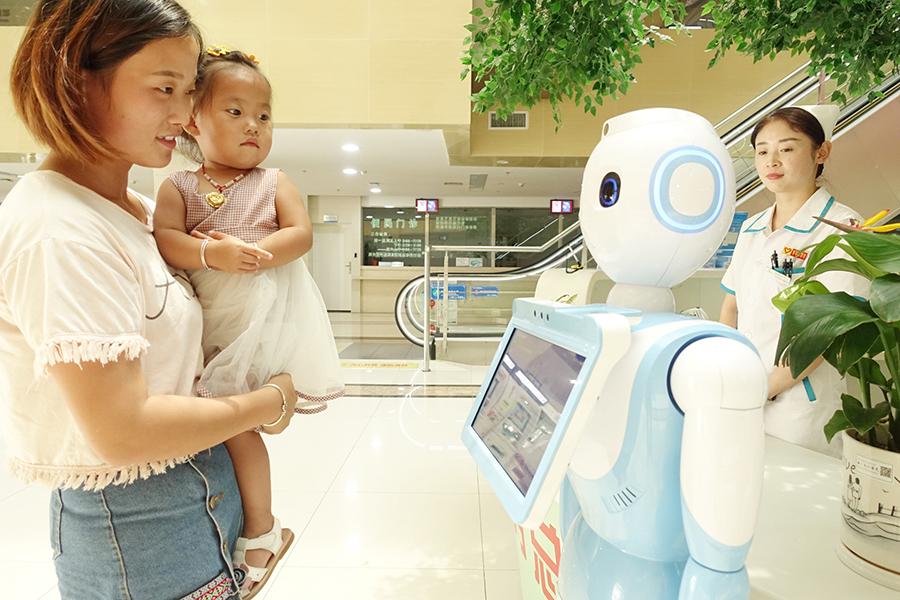 Two people interact with an intelligent guidance robot in Fuyang Women and Children Hospital in Fuyang, Anhui province. [Photo by Wang Biao/for China Daily]
Two people interact with an intelligent guidance robot in Fuyang Women and Children Hospital in Fuyang, Anhui province. [Photo by Wang Biao/for China Daily]
Beijing -- Information technology investment in the country's hospital system will reach 65.7 billion yuan ($9.47 billion) in 2022, surging 53.5 percent from 2017 and boosting the digitalization of the Chinese medical system, an Analysys report forecasts.
"IT investment is the basis of hospital digitalization. Although related investment is growing rapidly, the investment amount is less than 1 percent of the country's medical-related spending, a far cry from the situation in developed countries. With the deepening of medical reform and the increase of medical expenditure, China's hospital digitalization will develop quickly," said Chen Qiaoshan, a medical analyst at Analysys.
The Beijing-based research consultancy's report noted that the Hospital Information System has almost achieved full coverage in China's tertiary hospitals-the largest in the country's three-tier system.
Coverage in primary and secondary hospitals, the lowest two tiers, is currently at 80 percent.
In the future, China's medical system will shift its focus from basic digitalization to clinical digitalization that centers on patients, the report said.
Statistics from the Chinese Hospital Association showed that in 2017, hardware investment accounted for 44 percent of total hospital digitalization investment, while spending on software and services represented 56 percent.
"Software and services, as the core of hospital digitalization, have higher growth potential than hardware," Chen said.
From 2017 to 2018, 17.43 percent of the country's hospitals greatly expanded their investment in hospital digitization, and 29.78 percent slightly increased their investment, showing that in the future, the overall investment into hospital digitization will continue to rise, the report said.
Guangzhou Women and Children's Medical Center in Guangdong province topped the report's rankings for digitalization progress. Ruijin Hospital of Shanghai Jiaotong University School of Medicine took second place.
Since 2014, Guangzhou Women and Children's Medical Center has been devoted to improving its medical services by investing in IT. The hospital's internet-connected devices monitor patients' conditions in their own homes. At the hospital, all treatment processes are digitalized.
As a result, the hospital's average waiting time has been cut by 50 minutes, the accuracy of the intelligent guidance system is over 96 percent, and the smart diagnosis system covers 24 child fever-related illnesses.
Analysys forecast the hospital digitalization drive will deepen across the Chinese medical system.
The internet of things, image analysis and voice recognition are the three technologies that are most likely to be applied first during the process, according to the report. In particular, the development of these technologies will help hospitals to accumulate medical-related big data.
Qu Jing, another medical analyst at Analysys, said: "Although most hospitals attach great importance to information gathering, they don't have a clear development strategy. Statistics from the Chinese Hospital Association showed that 97.25 percent of China's hospitals have a specialized information and technology department, yet 56.29 percent of them lack thorough digitalization development planning."
Qu noted hospitals lack regional connectivity, which is important for the development of hospital information platforms, with only 49 percent having a regional information platform.
In addition, online hospital-patient interaction should also be strengthened, especially in areas such as printing receipts, sending notifications, arranging follow-ups, intelligent prioritization of cases, and registration.




 A single purchase
A single purchase









